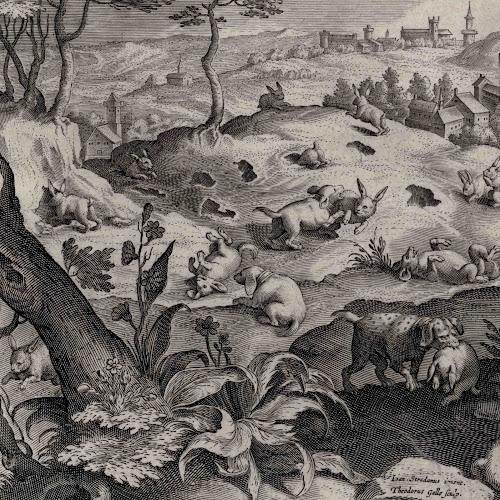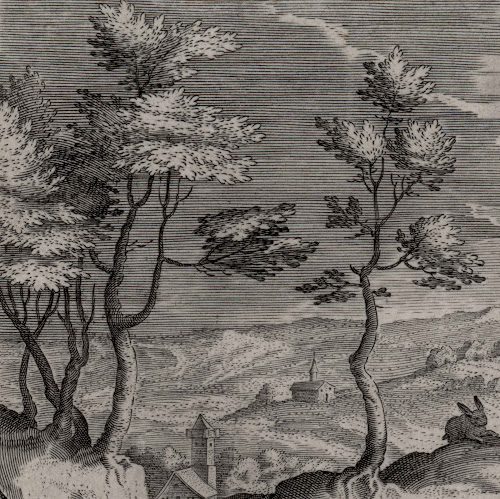Theodoor
Galle (aka Theodorus Galle; Theodor
Galle; Dirck Galle) (1571–1633)
“The King of England Hunting for
Rabbits”, c.1600 (1596–1638
[pub. date]), plate 35 from the series of 104 plates, “Venationes Ferarum,
Avium, Piscium”, after the design by Jan van der Straet (aka Joannes
Stradanus; Ioannes Stradanus) (1523–1605), published in Antwerp by Philips
Galle (aka Philippus Gallaeus; Philippe Galle) (1537–1612).
Note
that the British Museum holds a copy of this print from a later state with an
alteration to the plate number and offers the following description: “Plate
numbered 38, The King of England Hunting for Rabbits; in the right foreground,
the King, on horseback, bears dead rabbits suspended from the horse's reins,
while a small dog tries to leap onto the saddle; two companions on horseback
are seen beyond, to the right; to left, small dogs chase rabbits near a set of
burrows; a town is seen in the distance” (https://www.britishmuseum.org/collection/object/P_1957-0413-67).
Engraving
on fine laid paper trimmed with a small margin around the platemark, backed
with a support sheet.
Size:
(sheet) 21.2 x 27.8 cm; (plate) 20.4 x 26.6 cm; (image borderline) 18.4 x 26.4
cm.
Inscribed
in plate within the image borderline along the lower edge: (centre on stone)
“Ioan. Stradanus inuent./ Theodorus Galle Sculp.”; (right) “Phls Galle excud.”
Numbered
and lettered in plate below the image borderline: (left) “35.”; (centre in two
columns of two lines of Latin verse) “Callidus effossis latitare Cuniculus
antris/ Et generare Solet. Verum persæpe Catelli// Anglorum celeres fallunt Pecus:
ore prehendunt/ Illusum: prædam Venatori[que] minis Trant.”
State
ii (of iii) before the change in the plate number.
New
Hollstein Dutch 499 (Marjolein Leesberg [comp.] 2008, “Dutch and Flemish
Etchings, Engravings and Woodcuts ca. 1450-1700: Cranach–Drusse”, vol. 6,
Amsterdam, Sound and Vision, cat. no. 499).
Condition:
a strong and well-printed impression (near faultless) with small margins laid
onto a support of archival (millennium quality) washi paper. There is a
restored tear at lower centre, a hole near tree at right-of-centre and what may
be a printer’s crease in the margin at right.
I am
selling this remarkable early engraving, for the total cost of AU$320
(currently US$213.89/EUR193.53/GBP170.36 at the time of posting this listing)
including postage and handling to anywhere in the world, but not (of course)
any import duties/taxes imposed by some countries.
If you
are interested in purchasing this historically interesting engraving showing how
a royal hunting party for rabbits may have been conducted in England in the
late 1500s—for an interesting account of hunting at this time, see Roger B.
Manning’s (1994) “Unlawful Hunting in England, 1500–1640” (https://www.jstor.org/stable/3983583)—
please contact me (oz_jim@printsandprinciples.com) and I will send you a PayPal
invoice to make the payment easy.
This print has been sold

















































